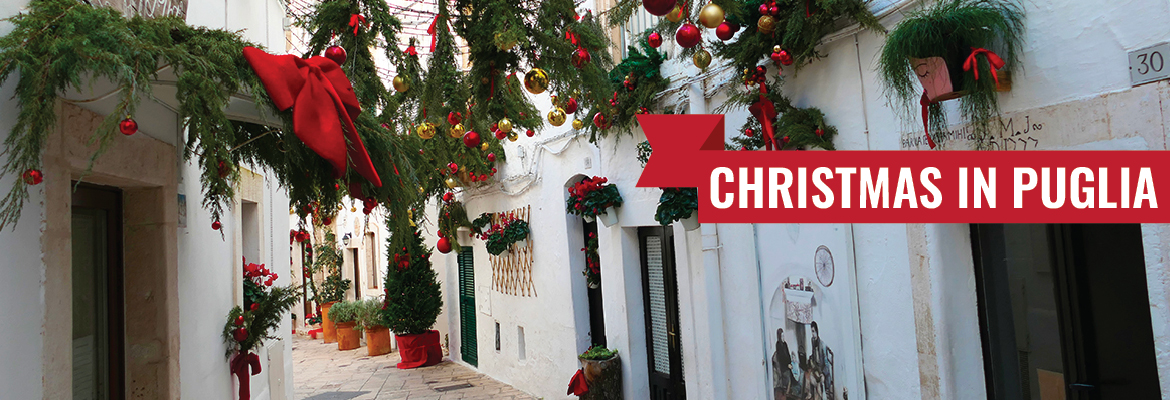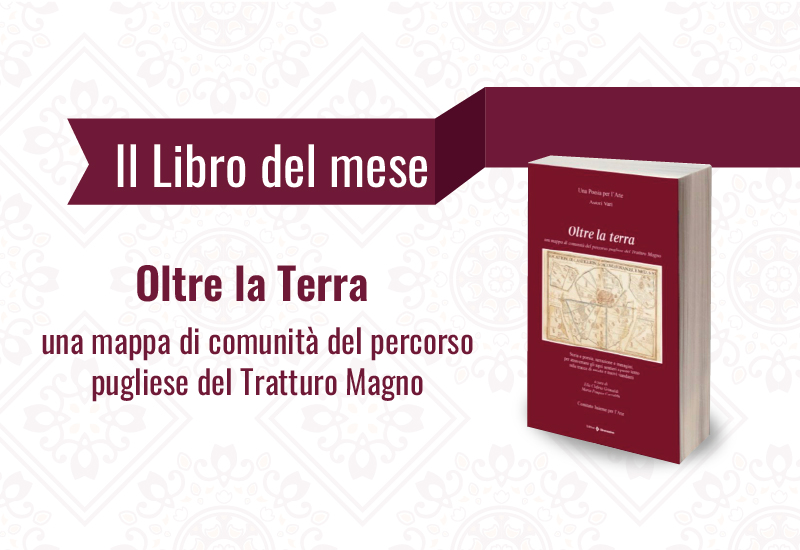Christmas in Apulia is one of the most exciting times of the year.
The Advent calendar is rich in traditions, skilfully combined with gastronomic specialities, the passion for nativity scenes and that enveloping folklore that warms the atmosphere. In the memory of every place, the scents and flavours of almonds and figs, ripened in the summer sun, return, protagonists on the laid tables.
Christmas in Apulia is a unique experience to be enjoyed, combining the sacred and the profane with the pleasure of exploring the Murgia and the Gargano with its Umbra forest, a Unesco natural heritage site, from the lush Valle d'Itria to the Salento through the history of Magna Graecia and places charged with the human creative spirit.
The landscape of Monte Sant’Angelo, a UNESCO World Heritage Site, during Christmas leaves one breathless. In ancient times, from 25 November to 25 December, each day was celebrated with an emotional and spiritual intensity that marked time and marked the approach of the festivities. In the days leading up to Christmas, various groups of pipers from Abruzzo and Basilicata in their pastoral garb sang Christmas carols and lullabies.
During mass on 24 December, pettole, typical Christmas sweets, are said to be prepared in several homes, while dinner consisted of a dish of 'laine, cicr e baccalà' (fresh pasta, chickpeas and salt cod) followed by roasted or fried eels, fried salt cod, barbecued sausages, pettole soaked in fig vincotto, calzoncelli (a kind of calzone) and wine.
Remaining in the Foggia area, Pietramontecorvino is another village that is listed among the 'Most Beautiful Villages in Italy' and an 'Orange Flag' by the Touring Club. Christmas is the perfect opportunity to discover this village, amidst artistic nativity scenes and theatrical performances.
In Capurso, the Christmas period is accompanied by a mix of events, markets and tastings until 6 January. Here, the queen event of Christmas is the Fanoje, which heats up the heart of the historic centre and the ancient piazza del Castello usually on the evenings of 7 and 8 December.
Fire also remains a distinctive element in Castellana Grotte, where from the beginning of December until 12 January Castellana dresses up for Christmas. The mundane events meet and embrace the religious ones: one of the most heartfelt by the faithful is the Diana, an evocative night procession among the olive mills of Castellana that precedes the celebrations in honour of the patron saint, the Madonna della Vetrana. This is followed by the Fanove, a night-long celebration, on 11 January, that has been repeated the same and different every time for 330 years. A festival that becomes a festival, a profane pilgrimage that succeeds every year in consecrating Castellana Grotte as the city of fire and flavours of Apulia.
Francavilla Fontana also opens its Christmas celebrations with a religious event. The feast of Saint Cecilia, celebrated on 22 November, anticipates the atmosphere of colours and lights typical of this time of year by a few weeks. Santa Cecilia is celebrated with travelling band performances and tastings of local gastronomic products. On 8 December, the city gets into the Christmas spirit with the feast of the Immaculate Conception, where on the markets set up for Santa Cecilia, there is no shortage of typical Apulian and traditional Christmas products such as pettole, cazzatedde cegliesi, panzerotti, typical local sweets and the inevitable vino novello (new wine).
The Immaculate Conception is also a very heartfelt feast in Molfetta, where the procession of the simulacrum of the Immaculate Conception is the highlight on 8 December. The beautiful wooden statue, probably dated 1700, is said to have been made by the Neapolitan sculptor Nicola Fumo. 'La Santa Allegrezza' is the popular Christmas carol of Molfetta, which begins to resound every year on the evening after 13 December, St Lucia's Day. Groups of young people intone the long prayer song in the streets with a final verse inviting the hosts to offer the delicacies of the period, such as 'Santa Lucia's eyes', baby Jesus' pads, cartellate and almond foam. Santo Stefano is instead the day of 'dù tridde', a typical Molfettese pasta cooked directly in meat broth.
Meat is the main ingredient of another municipality in the province of Bari: Sammichele di Bari. Here, zampina is among the foods that most identify the town both in the area and elsewhere, among the many bracerie and cookers where the spiral sausage attracts visitors every year. Christmas is a perfect occasion to taste local delicacies such as the aforementioned sausage, along with other products of equal goodness.
Every town during Christmas follows those customs that are identifiable to that place. Like in Bisceglie, where on New Year's Eve people wait for midnight with their families by playing bingo or cards. Until the early 20th century, a few minutes before midnight, it was typical to dress two boys, one as an old man with a hump, beard and cane, and the other as a teenager waving a flag.
Skilled craftsmanship builds the most beautiful nativity scenes in Apulia in stone, wood, papier-mâché, terracotta, plaster, allowing you to take home a fragment of emotion.
Taranto is among the cities where the tradition of living nativity scenes is more alive than ever. In the municipalities of Fragagnano and San Marzano di San Giuseppe, the settings transport visitors to another era. In Fragagnano, the nativity scene is set up inside a system of caves dug into the white tuff where visitors can taste hot pettole, fish and ricotta cheese prepared on site. In the ravine of the rupestrian Sanctuary of the Madonna delle Grazie in San Marzano di San Giuseppe, the nativity scene involves pilgrims along a path that winds for about one kilometre. Nearly 350 figures recreate glimpses of daily life inside the natural caves with representations of the crafts of the past.
In Vico del Gargano, a crib competition is staged every year, in which not only Apulian artists but also artists from all over Italy participate, and until 6 January, the streets, churches and porticoes are transformed into a museum to display these masterpieces.
Among the largest craft exhibitions in Apulia, Galatina 'Natale in fiera' is undoubtedly an unmissable appointment to get to know the local crafts, Salento food and wine and much more. Indeed, Salento is a part of Apulia where sweets grace the tables during Christmas: purceddhruzzi, carteddhrate, almond paste, mustazzoli and the hot pittule (the only savoury dish you can find all year round). Dishes that have become part of tradition because they are prepared directly by the people. Legend has it that in Galatina, before going to Mass on Christmas night, families leave the table set for the souls of the dead to enjoy.
Staying in Salento, Gallipoli is filled with artistic and living nativity scenes, all accompanied by the Pastorale, a melody composed by a Gallipoli musician that resounds through the streets of the city.
In the Grecìa Salentina region, Christmas is experienced with the tradition of the 'strine', the ritual song in the Griko language that accompanies the birth of Jesus Christ and is composed of sounds and words set to music by small groups of singers who intone them as they walk through the streets of the historic centre.
The Christmas atmosphere in the folklore of the localities of Apulia is best perceived on the tables, with all the traditional Apulian pastries, including cartellate, almond sweets, mostaccioli. Gastronomy unites all the territories, which in this period teem with goodness: in Bitonto it is a riot of Carteddate, Calzengìiddə, Cotto di fichi e mosto cotto, Scileppə (a sweetener used to cover sweets, especially taralli), Sasaniddə (today's sosamello) and Mastazzulə, which in imagination symbolise the sweets of the Baptism of Jesus.
Christmas sweets and homemade liqueurs (rosoli) are the expression of a rich and tasty popular tradition passed down from generation to generation.




